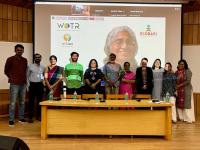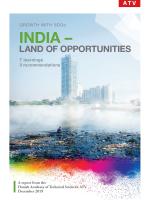The World's Leading Tech Regions - Testing Denmark's Capacity in Tech
English short version of our report that compares global activities in vital areas of technology.
Denmark might not be as competitive in its most favoured technologies as many of us think. This is the surprising conclusion in ATV’s analysis of global activities in research and patenting activities in the technology fields, which today are considered among Denmark’s competitive advantage. The thought-provoking conclusion of this report is that Denmark comes up short in seven of eleven key technology areas when measured against the world’s strongest Science & Engineering regions. The 11 technology areas include climate technology, water technology and medical and pharmaceutical technologies which, historically have been regarded as Danish strongholds. And in digital and data-transmitting technologies, Denmark is currently going from bad to worse.
Measured by patents per capita, Denmark only takes out 25 percent of what they do in densely populated regions such as London, Boston, Shanghai, and Tokyo, among others. The report singles out the 30 regions worldwide with the largest activity in patenting and research within technology areas that are of strategic importance to Denmark and where Denmark is therefore also more active compared to other areas.
Three critical observations are:
1. Denmark is not among the top-30 regions
2. In seven of the technology fields, Denmark takes out fewer patents per capita than the average of the top-30 regions
3. The biggest deficit is in “technologies of the future”, such as AI.
The analysis is a wake-up call to revise and sharpen Denmark’s technology strategy and the internationalisation of our research and development activities. Our economy and welfare are at stake. It is the wish of ATV that the report should be used as a road map for understanding and developing Denmark’s part in the global division of labour of the future, including an ambitious and coordinated effort in research, innovation and business development.
Taking the temperature on Denmark's strengths in technology
This report is the most comprehensive analysis to date of activities in research and patenting in technology fields of strategic importance to Denmark. The report is also the most comprehensive comparison of Denmark’s capacity in these strategic technology fields vis-à-vis other leading regions in the world. The analysis provides a picture of Denmark’s technology capacity in an international context, and the conclusion is unequivocal: Denmark’s competitiveness is under pressure.
If we want to keep up with the world’s leading tech regions, we must rethink Denmark’s future strategy for technology and globalization. The analysis is part of the Science and Engineering Project of ATV, the Danish Academy of Technical Sciences. It is carried out in cooperation with the Technological Institute of Denmark (TI). By way of data mining, TI has analysed millions of data points concerning research publications and patents from all over the world. Using research publications and patents as a proxy, the report benchmarks Denmark’s ability to develop knowledge and new products in selected technology areas that are of great importance to Denmark’s future competitiveness.
11 Strategic Technology Fields ATV and the identified 11 strategic technology fields:
• Advanced materials
• Artificial intelligence
• Biotechnology
• Climate technology
• Food technology
• Life science
• Pharmaceutic technology
• Robot technology
• Sound technology
• Water technology
• Wind technology
The tech fields have been chosen with an eye to the strategic priorities of the Danish Executive Board for Business Development and Growth (Erhvervsfremmebestyrelsen). Thus, the chosen technology areas are all areas in which Denmark historically has been highly competitive. In addition, the selection includes artificial intelligence (AI) and robot technology, which are two generic areas that are expected to drive future development in practically all other areas of technology and in business in general.
30 Leading Technology Regions
To have a benchmark against which to measure Denmark’s competitiveness, the analysis identifies the world’s 30 most productive regions in terms of both research and patenting activity. This is done for Denmark’s eleven strategic technology areas as well as for the 10 technology areas that saw the highest global activity in patenting (November 2019).
A Road Map to Future Global Division of Labour
This report is a road map for navigating and understanding the future global division of labour in tech. As such, the report is organised in three main chapters:
Chapter 1 – “Denmark’s Tech Strengths Illustrated by Use of Big Data” - analyses trends in research and patenting in global tech development over the last 20 years.
Chapter 2 – “The World’s Strongest Science & Engineering Regions” - provides an overview of today’s 30 strongest regions and an additional description of the top 10 regions.
Chapter 3 – “A Global Perspective on 11 Strategic Tech Fields” – lists the main actors of the tech fields and systematically reviews Denmark’s strength in each field and compares it to the Top 30 regions.
A New Benchmark
The analysis introduces a new index for benchmarking Denmark’s technology strength: the Top 30 Index. This new index compares the patent activity per capita in Denmark and compares it to the activity in the Top 30 regions. If the Top 30 Index is above 1, Denmark takes out more patents per capita than the average in Top 30, if the number is below 1, Denmark takes out fewer.
Main observations
Denmark’s Competitiveness is Under Pressure
In seven of the technology fields that are of strategic importance to Denmark, Denmark takes out fewer patents than the average in Top 30 regions. Only in four of Denmark’s strategic technology areas – biotech, food tech, sound tech and wind tech – the index is above 1. This puts Denmark’s future competitiveness under pressure.
Top 30 Regions Take out 40 Percent More Patents than Denmark
On average, the world’s 30 strongest tech regions take out 40 percent more patents per capita than Denmark. To be specific, the Top 30 regions take out 3.61 patents per 1,000 capita, whereas Denmark takes out 2.57 per 1,000 capita.
Denmark Lags Seriously Behind in Technologies of the Future
Denmark’s relative strength is especially weak in robot technology (Top 30 Index = 0.17) and artificial intelligence (Top 30 Index = 0.22). Likewise, Denmark is also lagging in the technologies that generate most activity globally, i.e. digital and data transmitting technologies. In this case, the index is also 0.22. This is worrying, since these “technologies of the future” will have growing importance for the development of most other tech fields.
Technology Is an Ever More Important Parameter for Competitiveness
In general, the analysis documents that globally, the activity in research and patenting has exploded over the past twenty years. This indicates that tech is becoming an ever more important parameter for competitiveness. On a global scale the activity in technology patents has grown around 350 percent. Over the last three years the growth has been especially strong. In 2019 alone, the number of publicized patents reached six million. Twice as much as in 2016.
Over the Last 20 Years, Denmark’s Relative Activity in Patenting Is Halved
Whilst the number of patents globally has grown approximately 3.5 times over the last 20 years, the activity in Denmark has only doubled. This means that Denmark is increasing its patenting activity at half speed, compared to the global average.
China Has Become the World’s Patent Factory
The analysis reveals a tectonic shift from West to East in the global balance of power in tech development. In twenty years, China has moved from an insignificant patenting activity to a dominant position in virtually every field in this analysis. A global ‘patent snapshot’ from November 2019 proves the point, since Chinese patent owners were behind two out of three patents. Europe is still strong on scientific publications, but when it comes to patents – as an expression of commercial use of technology – we are being left behind by the USA and by China.
ATV recommends that Denmark...
...rethinks and strengthens its strategic technology focus. It is necessary to rethink Denmark’s strategic priority for a new, global division of labour in tech development. ATV recommends that an investigation is initiated, with the purpose of pinpointing Denmark’s role and opportunities for competing and collaborating with the world’s Top 30 tech regions. This should include uncovering of niches and specialist areas where Denmark has a competitive advantage.
...develops an involving strategy. Starting from an identification of Denmark’s competitive advantages, we should put together an ambitious strategy for technology and globalization. The strategy must be based on a close dialogue involving not only academia and tech innovators, but also the labour market, the private sector, the large private foundations and pension funds, as well as a higher degree of coordination between the relevant ministries.
...invests in technologies of the future. Over several years, Denmark has underinvested in digital technologies. At the same time, the investments in the same areas have accelerated in the world’s strongest Science & Engineering regions. If we are to keep our competitive advantage in, e.g. wind technology and sound technology, we need to develop our competencies in AI and other data-based technologies. We must have an ambitious focus for the digital technologies of the future – in basic research, in capacity building, and in the areas where we already have a competitive advantage.
...creates strong ties to Top 30 regions. In a globalized world, knowledge is created jointly, and solutions flow freely across borders. Therefore, it is important to build strong relations to leading tech regions. Against this background, ATV recommends that relations to the Top 30 regions that are identified in this report, are strengthened, e.g. by way of university collaborations and by expanding and strengthening the Innovation Centre Denmark network. Also, Denmark should prioritize and influence joint European ventures to bring Europe on a par with China and the USA.






